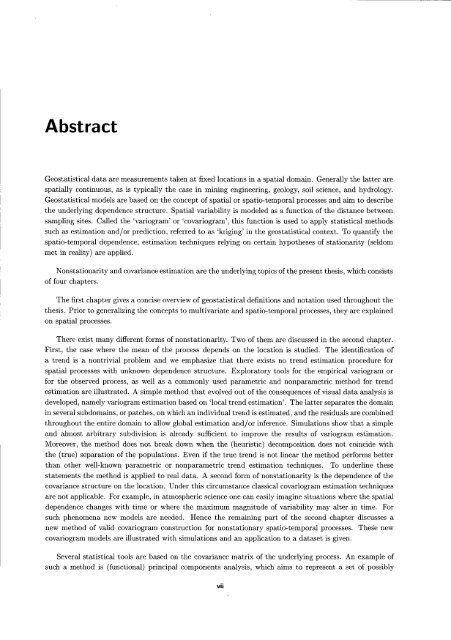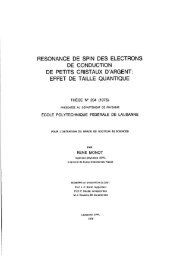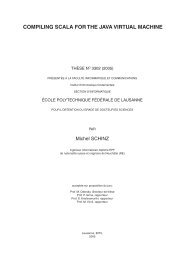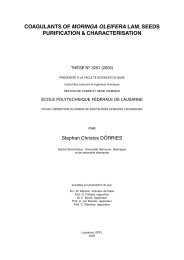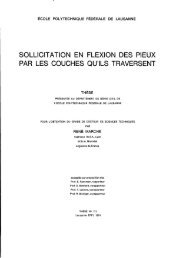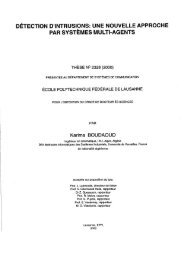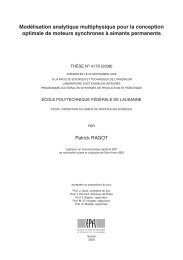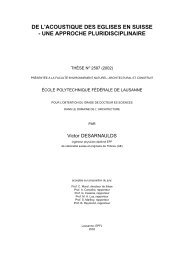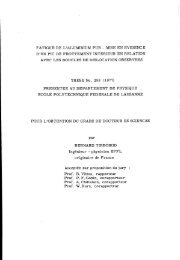nonstationarity, covariance estimation and state-space ... - EPFL
nonstationarity, covariance estimation and state-space ... - EPFL
nonstationarity, covariance estimation and state-space ... - EPFL
Create successful ePaper yourself
Turn your PDF publications into a flip-book with our unique Google optimized e-Paper software.
A bstract<br />
Geostatistical data are measurements taken at fixed locations in a spatial domain. Generally the latter are<br />
spatially continuous, as is typically the case in mining engineering, geology, soi1 science, <strong>and</strong> hydrology.<br />
Geostatistical models are based on the concept of spatial or spatio-temporal processes <strong>and</strong> aim to describe<br />
the underlying dependence structure. Spatial variability is modeled as a function of the distance between<br />
sampling sites. Called the 'variogram' or 'covariogram', this function is used to apply statistical methods<br />
such as <strong>estimation</strong> <strong>and</strong>/or prediction, referred to as 'kriging' in the geostatistical context. To quantify the<br />
spatio-temporal dependence, <strong>estimation</strong> techniques relying on certain hypotheses of stationarity (seldom<br />
met in reality) are applied.<br />
Nonstationarity <strong>and</strong> <strong>covariance</strong> <strong>estimation</strong> are the underlying topics of the present thesis, which consists<br />
of four chapters.<br />
The first chapter gives a concise overview of geostatistical definitions <strong>and</strong> notation used throughout the<br />
thesis. Prior to generalizing the concepts to multivariate <strong>and</strong> spatio-temporal processes, they are explained<br />
on spatial processes.<br />
There exist many different forms of <strong>nonstationarity</strong>. Two of them are discussed in the second chapter.<br />
First, the case where the mean of the process depends on the location is studied. The identification of<br />
a trend is a nontrivial problem <strong>and</strong> we emphasize that there exists no trend <strong>estimation</strong> procedure for<br />
spatial processes with unknown dependence structure. Exploratory tools for the empirical variogram or<br />
for the observed process, as well as a commonly used parametric <strong>and</strong> nonparametric method for trend<br />
<strong>estimation</strong> are illustrated. A simple method that evolved out of the corisequences of visual data analysis is<br />
developed, namely variogram <strong>estimation</strong> based on 'local trend <strong>estimation</strong>'. The latter separates the domain<br />
in several subdomains, or patches, on which an individual trend is estimated, <strong>and</strong> the residuals are combined<br />
throughout the entire domain to allow global <strong>estimation</strong> <strong>and</strong>/or inference. Simulations show that a simple<br />
<strong>and</strong> almost arbitrary subdivision is already sufficient to improve the results of variogram <strong>estimation</strong>.<br />
Moreover, the method does not break down when the (heuristic) decomposition does not coincide with<br />
the (true) separation of the populations. Even if the true trend is not linear the method performs better<br />
than other well-known parametric or nonparametric trend <strong>estimation</strong> techniques. To underline these<br />
<strong>state</strong>ments the method is applied to real data. A second form of <strong>nonstationarity</strong> is the dependence of the<br />
<strong>covariance</strong> structure on the location. Under this circumstance classical covariogram <strong>estimation</strong> techniques<br />
are not applicable. For example, in atmospheric science one can easily imagine situations where the spatial<br />
dependence changes with time or where the maximum magnitude of variability may alter in time. For<br />
such phenornena new models are needed. Hence the remaining part of the second chapter discusses a<br />
new method of valid covariogram construction for nonstationary spatio-temporal processes. These new<br />
covariogram models are illustrated with simulations <strong>and</strong> an application to a dataset is given.<br />
Several statistical tools are based on the <strong>covariance</strong> matrix of the underlying process. An example of<br />
such a method is (functional) principal components analysis, which aims to represent a set of possibly<br />
vii


